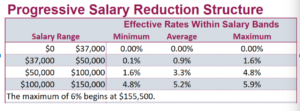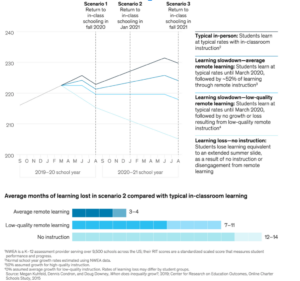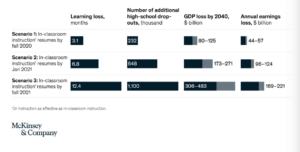In terms of the economic analysis of our solution, although we don’t expect major cost differences, there are a few key factors to consider. We hope to rewire what exactly a typical classroom setting will consist of and apply this to our new found online college experience. We would like to see increased class time and decreased time working alone outside of the ‘classroom’ (zoom sessions etc). First, it is important to consider the pay of professors pre-COVID. While one would be hopeful that pay of professors and faculty would remain the same, as remote learning has tried to replicate the experience, there is no question institutions lost money from things such as housing, meal-plans etc. Using Lafayette specifically as our example, there is no question that there are economic deficits and they have an unclear future for recovery. Tuition and room and board fees are most institutions’ bulk of revenue and with the 10% reduction in tuition itself, there are sure consequences for the college. For this example, we will say there are about 2,600 students enrolled at Lafayette College. Each student then is given the 10% tuition reduction due to COVID-19. Tuition was $28,278 prior to COVID and now it is $24,530 per semester. The difference is $3,748, and if we multiply that by the number of students we are averaging as enrolled, we get a 9.7 million dollar deficit. Evidently, there are other contributing factors such as students who may take a semester off or who choose to apply for access to facilities and things of this nature. Students who are just beginning their college education may simply opt out for a year (or two or three who know based on the circumstances) so, the College says they estimate a 10-30% fall in the number of enrolled students. An upwards of a $60 million dollar deficit is being anticipated. How does this affect professors specifically? The college opted for a progressive pay reduction. The pay reduction was for employees earning $37,000 per year or more and depending on salary level the reduction could be between 0 and 6 percent. Figure 1 below breaks down the relative salaries and their cut.
Figure 1

As one would expect, decreased salary for professors may affect incentives for remote learning as well as further implications to consider when analyzing our project.
There is a strong correlation between pay and incentive for teachers. In a study done at Stanford University, Thomas Dee explores the idea of whether performance based incentives increase successful teaching. In addition, threats of dismissal increased teacher performance by a significant amount. An important factor to consider when pay-cuts are being made is how this may actually affect not only professors personally, but the academic achievement of students. Dismissal threats specifically increased the effectiveness of teachers in the study by almost fifty percent. Financial incentives improved performance by a standard deviation of 0.24. These effects are pretty significant however, may be unavoidable in the climate in which online learning is prevalent and institutions must reduce their spending to compensate for the shift in learning from in-person to online. It is safe to assume that a long-term implementation of remote learning will not yield as dramatic effects from pay-cuts. As society becomes more acclimated to the new system, we can expect trajected decrease in effectiveness to increase when institutions adjust their long-term plans (Dee 2013).
A digital transition is driven by three things: time, quality, cost. In a publication written by Michael Kopp and his colleagues, Kopp proposes that a quality project is correlated with high costs. The costs that Kopp suggests are the costs for the need for digitalization, the training and support for those involved, and maintenance. Higher education has continuously changing budgets for technology however, a digital transformation requires additional costs for these institutions. Kopp says that unless these resources are not adequately invested in, then higher costs in the future will be the result. Another issue with an investment that isn’t sufficient would result in a competitive disadvantage. What he means by this is that an institution that doesn’t invest enough from the start will lag behind others who have invested an adequate amount for a sustainable digital development project. The investment consists of resources, communication, training, travel, material, and time. When investing into the project, there are multiple options for financing it. The options include external financing and internal financing, or a mixture of both. External financing requires a third party investor. For our example this would most likely be donors particularly alumni etc. The government could also be a plausible donor to a large institution. Internal financing would mainly mean taking funds from one sector of a higher education institution and placing that in the funding for the digital transformation. This is a sustainable way to use those resources not being taken advantage of when there are large changes being made to campuses. The best approach for our goal would be to start a savings and implement these external and internal funding ideas quickly and consistently. Waiting to obtain the funding will stall the transformation and thus become more expensive in the long run so it is essential to be efficient.
Up until now we’ve examined the economic needs and background behind digital learning but, not actually how digital learning will affect the economy itself. Research done by Thomas Kennedy of J.P. Morgan analyzes the potential economic impact that digital learning could potentially have. The research suggests that there would not be any significant negative impacts on the United States economy in the short term. In the long term however, there could be significant impacts on the long term economy. In terms of GDP specifically, research had estimated only about $50 billion dollars being lost which in comparison to the over $20 trillion dollar economy, is not significant enough to worry too much about. This estimate was not considering the disbursement of COVID-19 cases nor, the work requirements of the evaluated jobs. There are many factors that could potentially harm the economy evidently most of them stemming from unemployment and changes in the workforce. Specifically, with lower schools closing, parents will have to stay home with their children. The financial impact of this is smaller than expected because most businesses would not be allowed to have workers come into the workplace as well. For those jobs that are less flexible, parents wouldn’t be able to watch their kids all day even from home so they may need to hire someone else, or cut down their hours. Some workers may be forced to cut their hours because of their job, or even be left unemployed as businesses are closing or unable to function in a pandemic. The effects as you can tell are dispersed differently for a lot of people depending on their family make-up, professions, incomes, preferences, etc. Unfortunately, those with lower incomes tend to work in businesses that are most affected by COVID-19 like retail and the restaurant business. In regards to the short-term, this could mean pretty substantial changes in income immediately.
Along with the immediate impacts, closing schools will clearly threaten long-term productivity. Productivity growth is affected by the productivity of businesses, our leaders, education, high functioning institutions etc. Schools closing has a direct impact on the labor force which obviously has a significant role in the productivity of the economy. An important consideration here is the assumption that schools are ‘closing’. Schools are doing everything they can to function remotely however, this still affects the labor force involved as well as those people who may decide to put off different levels of schooling a year or two until things are normal. There is definitely a larger effect on children who were supposed to attend Pre-K or Kindergarten as these in person settings are what shapes young individuals’ mind, social skills, and physical abilities. This will for sure slow down the generational turnaround in the labor force.
This article suggests access to things like the internet and computers are the best option for preventing the potential impacts on education and thus the economy in the long-term. Research shows that 14% of kids in the United States (ages 3-18) do not have access to the internet at home. Without the internet, children will not be able to participate in online classes or complete assignments. In the long-term this definitely will put the lower earning individuals and families at a disproportionate disadvantage. It is clear there are disproportionate impacts on society and thus the economy resulting from remote learning on society (Kennedy 2020).
In an article published by McKinsey and Company’s Public and Social Sector written by Emma Dorn and others, startling evidence shows that educational institutions shutdowns could widen the existing achievement gaps. The shutdown of the United States education system, forcing the use of remote learning evidently questions the quality of learning that education systems have created and used for years. In this particular day and age, the disparities across not only income levels but, white students and those of black and hispanic heritage are undoubtedly prevalent. With the transition to remote learning these disparities are elevated which, in turn, are predicted to have long-term effects on these students’ economic stability and thus the economy at large.
As explored in the article above by J.P. Morgan, lower income households are more likely to have less resources needed to engage in a remote learning education system. Before the transition to digital learning, we acknowledged the increased likelihood of black and Hispanic students to live in lower income areas. In the past ten years the gaps in educational achievement have not been closing. The gap in productivity levels between white students and black and Hispanic students had an estimated deprivation of around $300-$500 billion dollars a year to the United States Economy at large. The gap in productivity of low-income students alone was ranging from $400-$600 billion dollars. This is equivalent to an upwards deficit of 8 percent in the total GDP. These gaps in ethnicities and lower income students before the forced transition to digital learning will undoubtedly compound in the future as the problem in our society has not improved in the past decade.
As we have set our goals for creating a more engaging and effective learning environment, the statistical models made by McKinsey and Company create a visual on how different groups are affected by receiving different levels of effective learning. It is clear there are different learning impacts on different types of students and this will certainly affect their economic standing in the future. The figure below, groups students into three different types; students who experience “average-quality” digital learning, students getting “lower-quality” digital learning, and students who are not receiving any digital learning. These types of students in the figure have predicted learning outcomes given different estimated returns to non-digital learning.

Figure 5. McKinsey and Company predicted learning outcomes by scenarios.
As shown in the figure above, all scenarios yield significant learning loss. Furtherly, this learning loss is predicted to disproportionately affect Black, Hispanic, and lower income students.
A shocking statistic found is that only 60-70 percent of students who categorize as black and hispanic students are engaging in their online instruction compared to 90 percent engagement from those who categorize as high income students. Low income students’ engagement rate is at 60 percent. It is clear that an upwards of a 30 percent gap is a significant problem. Another angle to consider is how these minorities are experiencing oppressive, systematic algorithms in their online activities like we discussed in class. Could these oppressions have something to do with their decreased engagement? The study specifically notes this could be due to having less access to devices, a more interrupted learning environment, quality internet services etc. The lagging behind of these students thus translates to increased dropout rates associated with the closure of traditional school systems. McKinsey and Company predicts drop out rates due to digital learning to be around the 2-9 percent range.
So how exactly does this translate to economic damage? In addition to the highly stressed institutional budgets, longer term effects are predicted for both the individuals involved as well as society at large. There is an estimated total decrease in annual earnings of $110 billion dollars. Broken down, there is a greater predicted decrease in annual earnings for black, Hispanic, and low income students. In the Figure 5 below we have these potential annual earnings loss translated into GDP loss using the year 2040 for reference.

Figure 6. McKinsey and Companies predicted learning loss translated into GDP loss and annual earnings loss by 2040 ($ billion).
As you can see the learning loss (due to the low engagement rates) could be detrimental to a whole generation and is most certainly something that should be taken seriously. Carrying out our ideas to create a better quality learning community is essential to not only the social and physical well being of students and teachers, but also our society. We hope to shed light on this potential economic downfall before it’s too late ( Dorn, 2020).
As a disclaimer, the models used in the figure does not account for college students however, we assume very similar impacts will take place. Changes in education at lower levels will certainly affect abilities for college admission, success-fullness, completion, and thus professional lives. Another factor to consider are even further out expected returns to school and the hybrid digital and in-person education that has and will take place in the future.
Aaron Skonnard, the President and CEO of Pluralsight, takes an interesting approach to online education and the effect on the economy. Most of the literature we have analyzed reviews the impact of digital learning cynically. There is no doubt these approaches hold true however, could digital learning be beneficial to the job market in some ways? The expansion of the technical industry is growing rapidly. Even in non ‘technical’ industries there is no doubt that businesses are rapidly growing their demand for mobile working, IT work, software development etc. The technological presence and fluency gives almost any business a competitive edge. A survey done by Randstad in 2013 says that IT professionals and software developers are in it’s top five most in-demand jobs. Additionally, the Bureau of Labor Statistics expected a 30 percent increase in employment of these jobs from then to now. Technological fluency is a highly sought after skill and exponentially growing especially in the context of the pandemic we’re in now. As we discussed earlier in this paper, the job market is tough and unemployment rates are high. With the transition to Digital learning as shown prior, we predict less students completing lower and higher education meaning, less individuals entering the workforce and thus negatively impacting our economy. Engaging in remote education with a focus on technology could potentially combat some of our problems.
The mobile workforce has essentially transformed our ways of engaging in business activities. So, as young adults and children are being fundamentally forced to engage in digital learning there is no doubt that this could prepare them specifically for the new way of business workings. The core pieces to the new way businesses are approaching work is putting an emphasis on software development and coding, all of which are primarily engaged in remotely. Up until the pandemic the education systems were not yet supporting the high demand of these areas. Increasing this focus in education is not only a potential additive to our economy due to the context we’re in, it is somewhat a necessity we had been lagging behind on pre-COVID-19.
We hope to create a more effective learning environment in the context of the current curriculum transitioning to digital learning. Additionally, incorporating more software development and basic programming at the lower levels could make significant changes in the potential devastating outcome that is a result of forced online education in our ‘now’. If we could shift the focus for younger generations, there could be less emphasis on the negative impacts and more focus on working with our rapidly developing digital environment. Better preparing the upcoming workforce could easily reduce the tensions associated with remote working and learning (Skonnard).